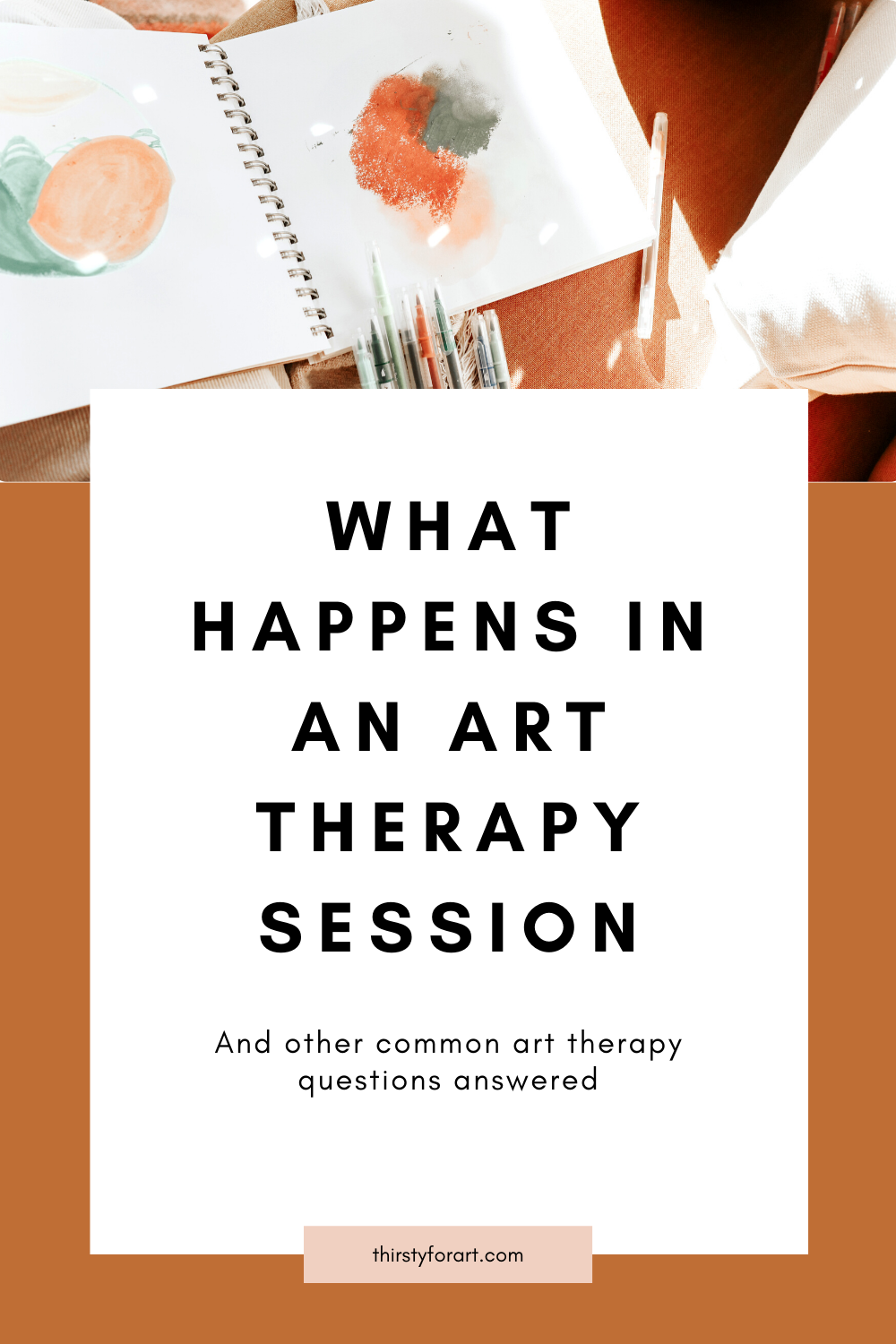What Happens in an Art Therapy Session
What Happens in an Art Therapy Session
Hello friends, today I will answer the question what exactly happens inside an art therapy session and some common questions about art therapy sessions I’ve gotten as an art therapist.
Before we start diving into the details, keep in mind that each art therapy session can be totally different. Because each session is dependent on the client’s needs and the situation, everything inside a session - from the type of art materials, to the amount that is available, how it’s laid out, the talking/discussion, what’s covered, etc - is designed by the art therapist to fit the client’s specific and unique goals & needs.
With that said there are some things that many art therapy sessions will commonly have. Continue reading below.
And if you want to watch the video version of this post, you can do so here:
* And pssst… if you’re curious what type of art therapist career path fits you the best, you can take my assessment/quiz here.
The art therapy session structure
How does an art therapy session flow? What things do you do in art therapy? To answer this question, I want to share the common structure that’s employed in art therapy session. This is broken down into 4 parts.
Checkin
The check-in part is the beginning part of the session. This is the time to see where the client is at, discuss anything that has come up since the last session, or even discuss the therapeutic goals together for the long-term, or for this specific session.
Art-making
The art-making part of the session can take up the bulk of the session, though keep in mind that sometimes art-making is brief and/or even skipped (and instead do verbal therapy) when it is therapeutically necessary for the client.
With the art-making part of the session, it can look very very different depending on the situation. But most commonly, there can be 2 types of art-making structure: unstructured or structured. In unstructured art-making, the client leads the art process and decides what to do. It is open for the client to do what they are pulled to do. On the other hand, in a structured art-making session, the client is given more structure - i.e., the art therapist provides a "directive" or a prompt for the client to guide them in their art-making. The art therapist also provides very specific art materials suited for the client. So the choices and art-making process is purposely specific.
During the art-making, the art therapist can be there to just witness your process, or even collaborate or make art together. And the artmaking process can look very silent, or quite talkative, depending on the session.
Discussion/verbal processing
After the art-making, art therapy sessions often involve discussion and verbal processing. This is when the client talk about their artwork, the art making process, and whatever came up from the art. Or, they can also talk about the needs/goals they want to address (e.g., whether that's touching on trauma, addiction, or just losing a job, or being a mom.) within the session (which inevitably always connect to the artwork in many ways). Art therapist can ask certain questions to prompt the client, or it can be more flowing and unstructured.
Closing activity
Most art therapy sessions involve a “check-out” or closing activity. This is to help the client review the session, plan ahead, and/or transition from the session back to their everyday life. Activities might include talking or more physical (mind-body) check-in.
Now, you might have a few more questions about art therapy sessions…so below I’ll be answering some of the common questions I’ve been getting about this topic.
Common questions about art therapy sessions, answered by an art therapist
Does the art therapist create art alongside the client? Can you work on a piece together?
They can, in some situations when the art therapist sees the need for it and it is therapeutically helpful for the client.
Other times, the art therapist is there to help the client when it’s needed and is mostly there to hold the space and witness the client’s art-making process.
Can you use multiple mediums and techniques (like finger painting, embroidery, puppets, woodworking, etc)?
Art therapy involves a wide variety of mediums, and art therapists are familiar and well versed in many different mediums - anything that allows clients to express themselves, they can definitely use.
Do you talk during art therapy?
YES - talking is also an important part of art therapy. Art Therapists are trained in talk therapy and counseling, so sometimes talking might be the only thing that's therapeutic in the session so that's what you'll do. Talking is used to check-in with the client, understand where the client is, process whatever thoughts/emotions that come up during or after the art making process, as well as work toward the client’s therapeutic goals such as developing coping skills, solve problems, overcome challenges, etc.
What questions do art therapists ask?
Art therapists ask a wide variety of questions. Questions are posed to help client identify their emotions/thoughts, gain clarity around a situation, understand themselves better through the artwork, as well as achieve any therapeutic goals like identifying coping skills, solve problems, overcome challenges, find new perspective, creating plan of action, etc.
Some example questions an art therapist may ask around client’s artwork are:
What feelings come up as you look at the artwork?
What kind of place is this (e.g., if it was a landscape image)?
What part stands out to you? Why?
What’s blocking your path?
What would be an image of a solution look like?
Can art therapists diagnose?
Sometimes yes, but it depends on the situation. In order for an art therapist to make a diagnosis, they would need to be recognized by the state to be a psychotherapist who can give diagnosis. So in states where art therapists are not licensed nor recognized as psychotherapy treatment providers, then no.
What happens to a client's art after session? Do they keep it, or it depends?
It depends. Most often, if the session happens at a dedicated facility or studio and there is a confidential storage space, artwork can be kept in the studio, when the client wants to keep it there. Depending on the rules/regulations of the space, the artwork is kept for a designated amount of time and safely discarded afterwards. If it involves a mural project, a group/community project then the artwork is more publicly kept. But ultimately the artist (the client) makes the decision of what to do with the artwork.
Does it happen sometimes, that a client starts crying and it's impossible for them to continue making art? What an art therapist should do in this case?
That can definitely happen. Art therapy can be a safe space to express our emotions and process our feelings. The art therapist would hold that space for the client, and depending on what is appropriate, the art therapy can talk with the client to process what came up, check in, and incorporate whatever came up into the art-making as well.
How long does it take for art therapy to work?
Like therapy, this is totally dependent on the therapeutic goals and the situation client is in. Sometimes clients have short-term goals, so they only attend 1 session, but that is enough for them to get what they need out of the session. But other times, clients need to see art therapist for months, or years. You get the therapeutic benefit of art therapy, most likely from the first session. But depending on your needs, you can continue the process for ongoing support.
Let me know if these answers helped you understand a bit more about what goes on inside an art therapy session. Do you have any other questions come up? Share in the comments below.
P.S. If you want to explore art exercises that are more expressive and therapeutic art, for your own self-care, check out my Therapeutic Art Library Vault. It’s a calm, cozy space filled with over 300 therapeutic art prompts, journaling exercises, creative reflections, and recorded artmaking sessions. TheVault is your forever-access resource for slowing down, creating art for your own self-care, and reconnecting with yourself in a creative way. Check it out here.♥︎
--





